Remember back in grade school when your teacher gave you a dixie cup full of dirt? You planted a flower seed, kept the cup in the window and watered it each day.
Your flower sprouted, grew and bloomed. Then you carefully brought it home for Mother’s Day. (For many of us, it didn’t survive the journey home!)
We are taught at a young age that flowers and plants need plenty of sunshine and water in order to grow. While that is mostly true, it is also true that there are a number of beautiful shade-loving flowers and shrubs that prefer to live in the darker areas of your yard.
Finding plants to grow in partial shade is fairly easy. Finding full shade plants can be a bit of a challenge. I hear all the time, “Nothing but moss will grow in the dark corner of my yard” or “I have a beautiful shade tree out front, but nothing will grow under it”.
Here is my recommendation of 25 full shade plants that will look great in your yard.
(*In no particular order.)
#1 Hellebore
Sometimes called the winter rose, hellebore blooms in the late winter or early spring. Blooms come in a wide variety of shades- white, red, pink, purple, orange, yellow, tan… With leathery leaves and thick petals (not to mention winter blooms! ), you’d swear this plant is fake. They grow in zones 4-9.
#2 Hydrangea
When it comes to flowers, hydrangea go for the gusto. The huge flower clusters bloom late spring into early autumn as either mophead (large round or conical clusters) or lace cap (flat, loosely arranged blooms).
While white hydrangeas will always bloom in shades of white, the pink or blue flowering varieties can be changed by the soil. The more acidic the soil, the bluer the blooms will be. Alkaline soil produces pink blooms.
#3 Astilbe
Astilbe is a cute little bush with interesting leaves that add texture to your landscape. They sport red, pink or white flowering plumes in the spring through summer months. They are tolerant of wet soil and grow well in zone 3-9.
#4 Viburnum
Most viburnums tolerate partial shade fairly well. There are a few like the Mapleleaf, Arrowwood or Leather Leaf that perform quite well in full shade.
The leather leaf viburnum pictured above gets pale yellow, showy blooms that are fragrant each May. As fall approaches, it gets red (or sometimes black) fruit. Viburnums can grow up to 15 tall but are easily pruned to stay at a smaller size.
#5 Taxus
The taxus (sometimes called a Yew) is an evergreen with dense growth, making it perfect for low maintenance hedges. The females produce colorful red berries.
This shrub is tolerant of dry soils. Although the yew is a popular landscape plant, it should be noted that this plant (particularly the seed inside of the berry) is extremely poisonous. In fact, the name taxus means toxic. Please watch pets and small children around this plant.
#6 Browallia (Bush Violet)
Browallia is grown as a warm-weather annual throughout much of the United States. In zones 9 and 10 it can be kept as a perennial.
This bushy little plant grows to about 12″ high and produces lavender to dark blue trumpet-shaped blooms. The secret to keeping browallia happy in moist soil with good drainage. A few hours of filtered sunlight will also help to keep it blooming.
#7 Ajuga (Bugleweed)
Ajuja (often called bugelweed) is a fast-growing creeping ground cover. The leaves have a rich copper or deep purple coloration. With more sunlight, the foliage tends to display more green hues.
In early summer ajuja grows a tall, purple flower stalk that is very similar to hosta. The plant itself stays under 6 inches tall. Its deer resistant and found in zones 3-10.
#8 Bleeding Heart
Bleeding hearts get their name from their shapely flowers. Early spring brings rows of heart-shaped flowers in shades of pink and white. The plant will grow to 2-3 feet in height and thrive in zones 3-9. They are deer resistant.
#9 Deadnettle (Lamium)
This spreading ground cover displays a beautiful silver-toned leaf. It grows best in the moist shade and is known to be deer resistant. It’s a fast spreader, but not invasive. Flowers can be white, pink or purple.
#10 Clematis
Although often seen as a trailing perennial vine, clematis can be trained into shrub form. It grows best in partial- full shade and produces spectacular flowers.
Something to note (especially if you are having problems with your clematis blooming): Much like hydrangea, some clematis bloom on new wood and some bloom on old wood. Find out which type you have before doing any heavy pruning.
#11 Vinca Minor (Periwinkle)
Around here, it’s pretty common to run across a patch of vinca while walking through the woods. This trailing evergreen vine produces small purple flowers throughout most of the year. It’s a good spreader and is great for filling in bare patches.
Vinca can also be found as vinca major (a slightly larger, more invasive version) and as annual vinca (a completely different plant that loves full sun). In some areas vinca minor is considered invasive, in others it is sold as ground cover. I have a patch in my landscape bed and I have found it to be easily contained.
#12 Pachysandra
This evergreen perennial ground cover stays under 1 foot in height. It is tolerant of clay and dry soil and gets delicate white flowers in the early spring.
#13 Bunchberry Dogwood
Bunchberry dogwood is not a tree, but more of a low growing creeper. The white flowers and red berries look just like what we have come to expect from a dogwood. This plant is tolerant of wet soil and prefers cooler soil temperatures. It grows best in zones 2-6.
#14 Euonymous
While many varieties have dainty yellow or white flowers, its the foliage that gets noticed on this plant. The variegated leaves on this low mounding hedge plant do a great job of lightening dark areas.
This compact evergreen is often pruned to about 3 ft in height. They are great for hedges, foundation areas, and erosion control. They grow in zones 4-8.
#15 Bergenia (Pigsqueak)
Bergenia is also known as Pigsqueak because of its thick, leathery cabbage-like leaves. When you rub the leaves, they squeak! This low growing plant (up to 12″) makes a great ground cover. Bergenia is best suited for zone 3-8. April and May bring white to deep pink blooms. It is tolerant of drought and dry soil.
#16 Fern
With over 12,000+ species there are very few places that a fern cannot grow. The majority prefer to grow in warm, shady areas.
Ranging in sizes from itty-bitty (2 mm) to humongous (80 feet) you’re sure to find a size that fits perfectly in your shady garden. Some (such as the Japanese painted fern) come in shades of silver that almost seem to glow.
#17 Wood Sorrel (Oxalis)
Oxalis bulbs produce shamrock leaves that can be bright green, purple or any variation in between. Its dainty flowers are usually yellow or white, but they can be found in shades of pink and purple. They are incredibly easy to grow from a bulb and look best when planted in tight groupings.
#18 Kerria Japonica (Japanese Rose)
This showy, spring-flowering shrub is tough as nails. It grows in both wet or dry soil and blooms heavily with yellow pompom like flowers. The foliage resembles that of a rose- minus the thorns. This plant can be grown in zones 4-9 and typically reach a height of 3-6 ft.
#19 Creeping Thyme
Creeping thyme is a really neat plant. It’s ground cover that can be walked on. It’s really low growing (2-4 inches) and spreads to about 2 feet. Its a great, low maintenance plant for walkways and filling in bare spots where the soil isn’t too wet.
Creeping thyme gets small purple flowers late spring into early summer. In sunnier areas, they flower so much that you can barely see the leaves. In full shade, they won’t flower quite as much.
#20 Heuchera (Coral Bells)
Heuchera is a low growing (6-12 inches) with mounding clumps of crisp leaves that look good enough to eat. There is a huge variety of leaf colors and patterns available.
Foliage can be variegated or marbled in shades of green, gold, purple and red. In late spring to early summer, they will produce a stalk with bell-like blooms in white, pink or red.
#21 Brunnera
I just love the large, heart-shaped brunnera leaves. Some varieties (Like Jack Frost) have variegated foliage of silver and green. Clusters of tiny blue flowers (similar in shape to a forget-me-not) bloom each spring. Brunnera generally prefers moist soil and grow in zones 3-8.
#22 Geranium
There are many types of geraniums that thrive in both sun and shade and come in every color imaginable. Most geraniums are perennial in zones 9-11 and are often planted as annuals in cooler climates. (They can be overwintered to survive for a number of years.)
#23 Hosta
Hosta is hardy in zones 3-8 and known to be one of the simplest plants to grow. They will grow in places where nothing else will. They get a stalk of purple or white bell-shaped flowers, but they are mainly grown for their foliage. Leaves can be variegated, yellow, green, blue, ribbed, heart-shaped, striped… There’s a hosta to suit everyone!
#24 Albutilon (Flowering Maple)
Flowering Maples (like the one seen above) are grown as houseplants here in Ohio. In zones 8-10 they can be grown outdoors as a woody shrub that reaches heights of 8 feet.
Even in full shade, this lovely plant flowers year-round in shades of red, pink, orange and yellow. The flowers look like a cross between a mallow and a hibiscus (to whom it is more closely related than the maple). Albutilon is not really a maple, but the leaves make it easily mistakable.
#25 Impatiens
When it comes to shade flowers, you cannot go wrong with impatiens. They come in nearly every color available and are a no-fuss annual that is sure to add lots of color to your shady area.
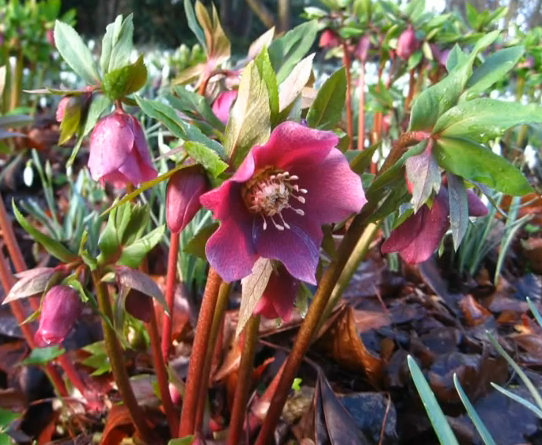

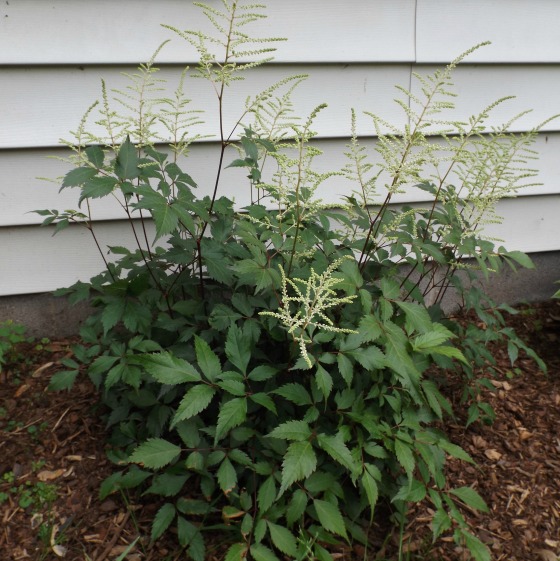
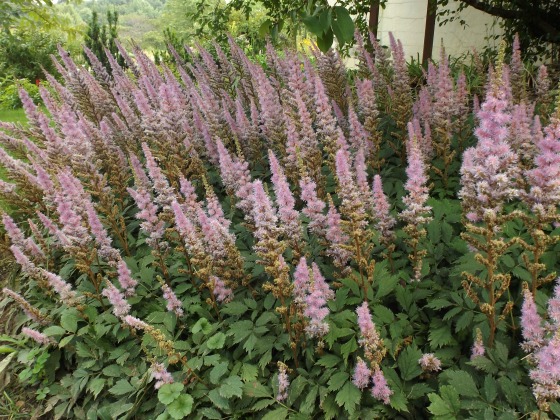
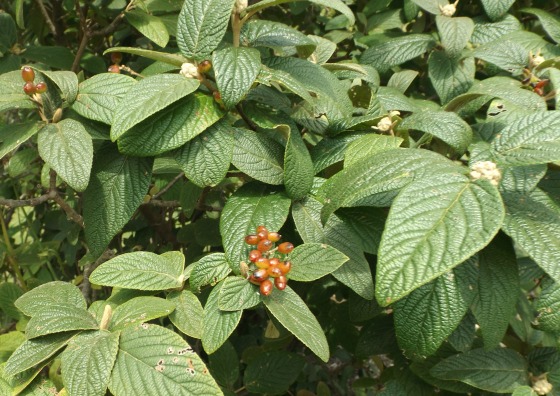
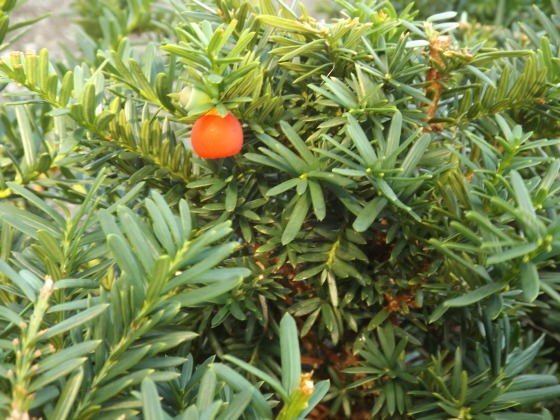
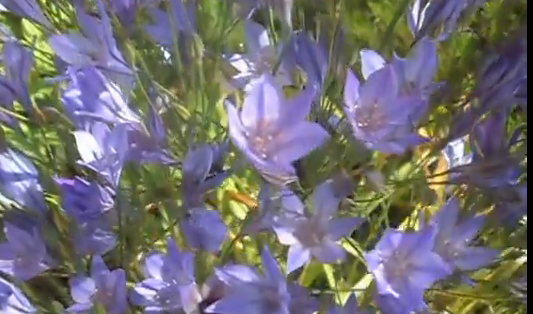

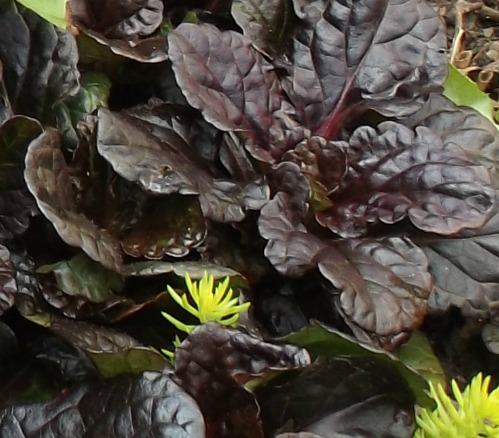


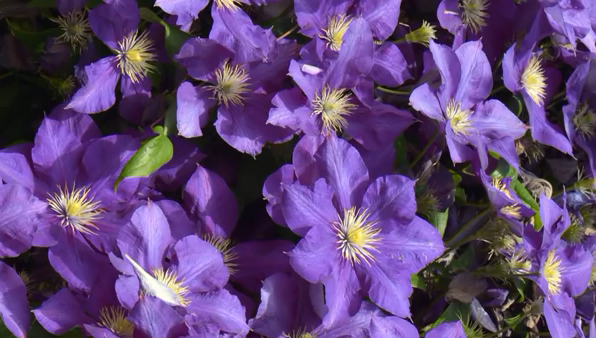
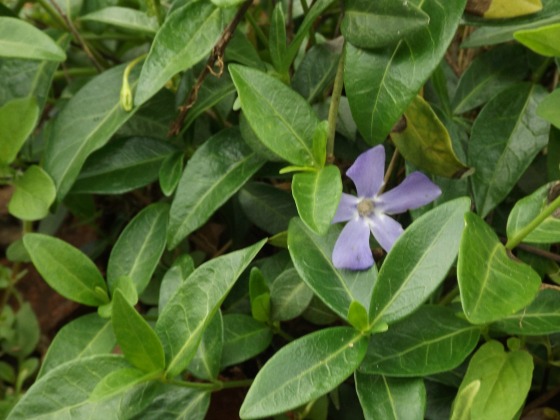
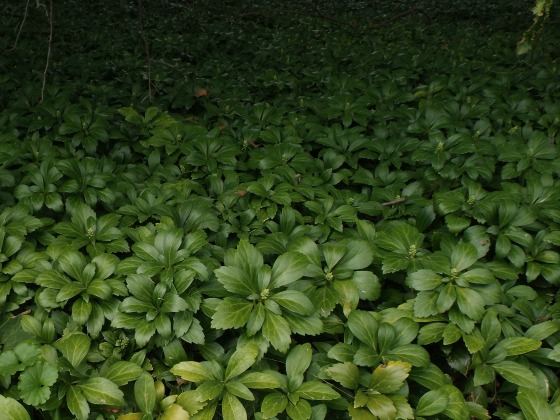
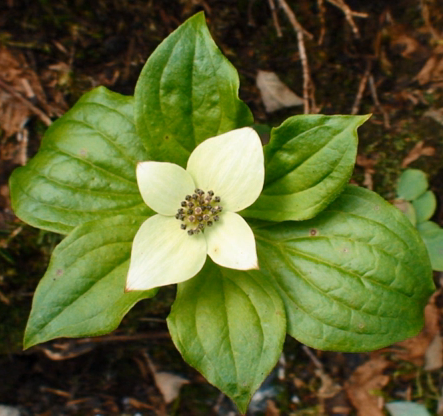
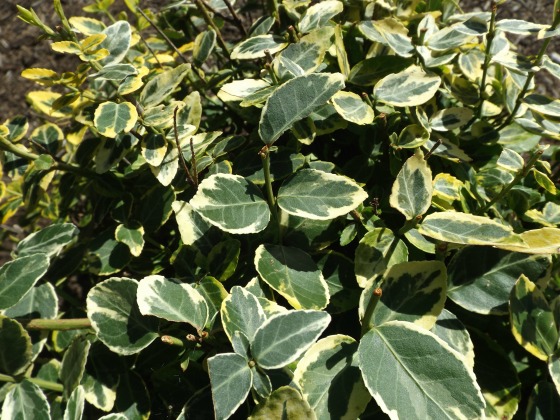
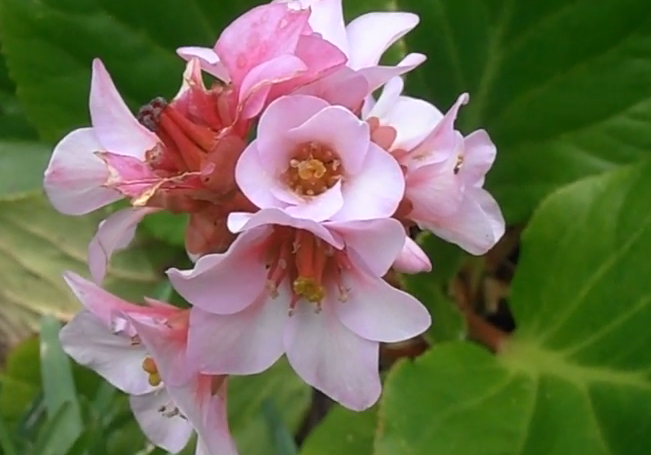

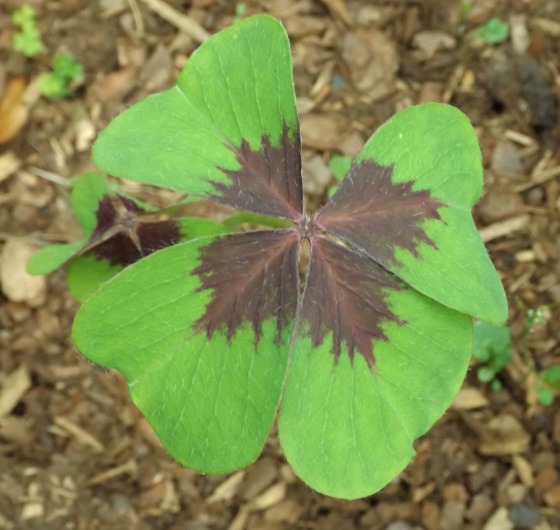
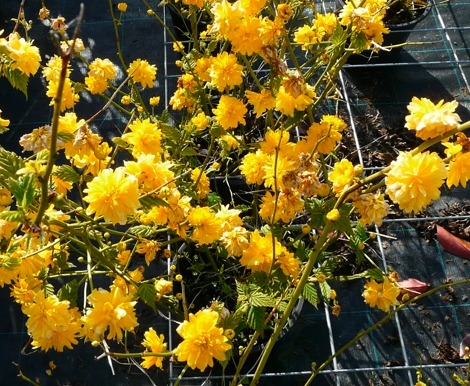
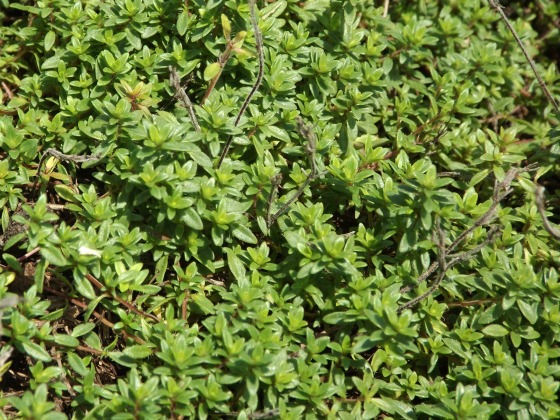

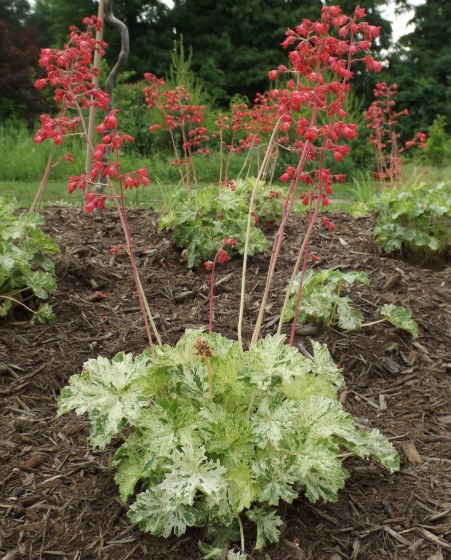
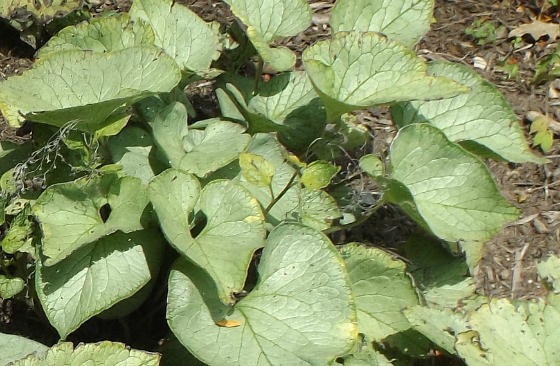
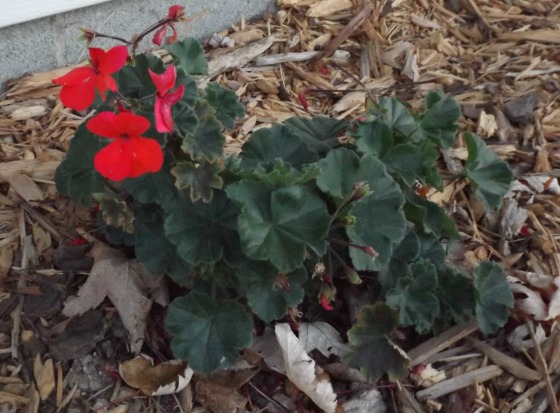
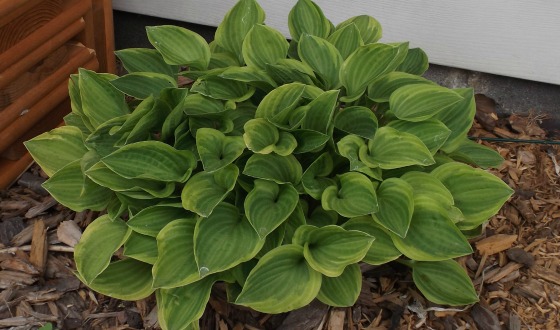
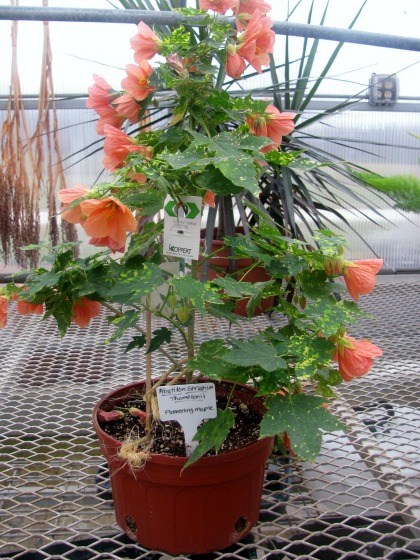
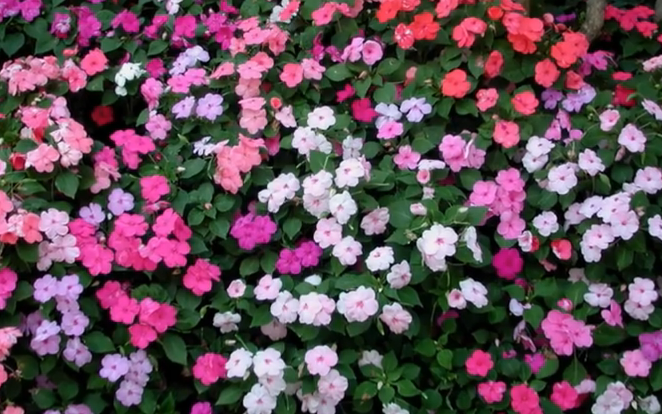
Mikey-you forgot woodruff and lily of the valley that takes over under the dense oak canopy here in northern Illinois.
Mike, your Euonymous doesn’t look like the Euonymous we have around Tulsa, which grows quickly just about everywhere, in all different shapes and sizes, high and wide if you let it, usually dies into ugly gangly sticks after a few years. How so?
There are a lot of different kinds of Euonymus from burning bush to variegated shrubs to creeping euonymus like euonymus coloratus. Most varieties get euonymus scale which is really hard to get rid of once you have it. See this https://extension.psu.edu/euonymus-scale
I have a side yard with a large pin oak tree. I have a hard time keeping any kind of grass growing due to the shade. Is there some kind of plan to use some of these shade plants in place of grass. Sometimes I wonder if the pin oak saps the soil of moisture.
Ronald,
For sure the tree keeps the area really, really dry. I really don’t know how well shade plants will do under there. ????
Sone time ago Mike features a bright red plant that was one of his favorites. Can you tell me the name of the plant?
Terrence, could have been a red coral bells or a Japanese maple. ????
Hi Mike, I would like to include Clivia to your list Glossy strap shaped leaves and clusters of larg orange trumpet shaped flowers. I have only grown it in California, so I don;t know how it takes the cold wnters.
I am planning to grow Hog Peanut as a vine in the shade. I know it has a reputation as invasive, but this is on concrete in a container.
Mike, thanks for the list. Many plants that I hadn’t thought of before.
Have you noticed the creeping of grow zones? I live in upstate South Carolina. When I was young it was zone 7a. When I grew up and got married, it was 7b. Now it is listed as zone 8
You are absolutely correct. We used to be zone 5, now were zone 6. After they changed it it dropped to 22 below zero that winter. Not sure that I agree with the new zones.
Totally agree with your viewpoint on the new zones. We live in Grand Rapids, Michigan (zone 5, I think) and our last frost date is the beginning of May. However, more times then not we get a hard frost the week before memorial day. Therefore, we plant our least tolerant plants on Memorial Day weekend.
For areas where regular vinca is too vigorous, try Illumination Vinca, which is gorgeous yellow and green variegated,
Shade-loving and deer resistant. Oh boy, that would take the cake. All season we did well with our impatience until now when they ate the tops off of our old wheelbarrow display. I get it. I think they are pretty darned hungry. I love the deer too, but my loaf of homemade rye bread doesn’t go far enough.
In the back of Deer hunter magazines you can find an ad for free packets of seed. Plant as deer food away from your decorative garden. Maybe the deer will enjoy the clover and grasses so much they will leave the flowers alone. MAYBE!
Deer were eating the buds off my roses. A little cayenne pepper solved the problem. You do have to sprinkle again after a rain.
I absolutely love the different varieties of the Fatsia Japonica for shade! Especially the Camo variety.
Try Clivia Very pretty clusters of orange flowers and glossy strao shaped leaves, About 8 to 10 inches tall clumps.
From this list of 25 plants, which plants are deer resistant?
Paul,
That’s a different list, I need to compile and post one.
Anything with a strong smell like rosemary and lavender. They steer clear of mint family and a drought tolerant bush called Brass buttons. Germander seems to ward them off. Try Catmint. The sage family might work too.
We worked at an old estate in the Santa Cruz mountains where the deer had been protected for years. The fauns are tall goats. They will nibble everything!
Hi Mike,
I very much wish you would investigate the need for using native plants. Natives support wildlife – birds, bees, butterflies. Non natives do not.
thanks,
Paula
Paula,
I’m not sure that I agree with your statement all. Natives are great I’m sure and I am certainly no expert on them. But I have all kinds of named variety plants that are absolutely loaded with bees, butterflies and hummingbirds. Honestly there is not a lot of difference between a native plant and a named plant. Most named plants are simply a sport that originated from a native plant. Possibly superior to and a better choice because the sport was selected because of profuse blooms etc.
Yes
There is a big difference between the two.
Depends on where you live. Sagebrush and cacti don’t support wildlife as much as lavender and daisies. I adore natives and plant all the things!
Buddleja (butterfly bush) is not native and was surrounded by a cloud of butterflies in my grandmother’s garden. We had a ground cover called Lippia that the bees loved. Hummingbirds are attracted to red lantana. The list goes on and on.
Coleus is another great shade plant. You can keep it low by pinching out the top before it blooms. You can root the cuttings in a glass of water. My friend has some coleus ‘descendants’ from her mother’s plants from many years ago,. They are a tall coleus – like 3′ tall! She takes several cuttings in the fall and roots them in glasses of water over the winter and plants them in the spring.
Laimium “dead nettle”… and “foam flower”… are both great here in the shade too..,.? Anything we can do to brighten up our shade area’s is always a beautiful thing. I have deer constantly visiting and I just plant more varieties of hosta… I don’t worry if someone takes a little nibble… we have a large National Park that I really wish would plant some corn or sorghum along the low areas… the full size deer have mutated because of a lack of food…. nothing other than the neighborhood Landscape’s… and no hunting pressure to the size of large dog’s… I’d much prefer to see hunter’s controlling their herd size then to see them starving so badly that they have shrunk to the size of a large dog…totally inhuman!
Damp sand with a cover…flipped aquarium with 1” blocks on it’s corners…. works great too…I’ve not had much success rooting anything that I’ve left in a water bath… too much humidity can be just as bad as not enough…??? I’ve fallen in love with air laying… avoids the headache… 😁👍
Coleus rocks!! I love planting them in large pots with impatients! With the huge selection of colors the arrangements seem to glow in the shade!!
There is a pretty relative of coleus that produces clusters of lavender flowers and grows in full shade. Plectranthus. Grows about 12 50 15 inches tall and wors as a house plant too.
Hey Mike,
I really enjoy your blog. But euonymus and periwinkle are invasive species where I live. I guess I tend to go more on the native side. I really like most of the other plants you recommended.
lily of the valleys also grows under the dense canopy of oak & walnut.
Can’t get rid bbn of lily of the valley very invasivr
it barely survived for me.
My Lily of the valley emerges early spring just after the Lenten rose buds appear and sweet woodruff begin showing. I love this time in my gardens. All 3 tend to spread easily and Lily of the valley has toxic properties.
Hey Mike, A little off subject-
The J Maple you and your son trimmed, how long did it take to leaf out?
I have a mountain ash in my front yard, beautiful tree white flowers in spring, red/orange berries
in the fall. This tree is 25-30ft tall.If I trim it down to 12-15ft, would it grow back or am I killing it?
Thanks Mike, Tom
Tom,
I can make any promises but it should respond fine if you do the pruning when it is dormant.
Great Article Mike! This something that people should print out and keep in their collection!
Where else are you going to get information like this Folks?
Thanks Jim, glad you found it useful.
This year, my mom decided we should work on our garden. Thanks for explaining the Clematis grow better in partial-full shade areas. I will take her to a garden center so she can pick her own flowers and plants.
At my condo building there is a very, very shaded area. One part is partialy shady. There is ground cover that is doing ok on some areas, but big bare patches on some. I have been told that the soil may be to blame, It is very old. Is that why what is planted in some areas dies?
Patricia,
In most cases it is not the soil to blame. The soil may not be great, but most soil will grow something.
Oak trees live to be 200 years old in the same soil. God does not “change the soil” Just add some mulch or compost to it!
I like most of your recommendations, however it’s a shame that you recommend INVASIVE plants like Pachysandra (aka Japanese Spurge) and Periwinkle. Glad you didn’t recommend English Ivy in this shade loving roundup! I live in Georgia and support our NATIVE plants – the invasive’s are killing us,
Certain plants are invasive in some regions, but not in others. I live in Portland, Oregon, and while English Ivy is a definite no-no, Pachysandra is fine. So it’s difficult to criticize this roundup without considering different regional attributes.
Good play on words “:Roundup”
What are some heavy shade plants that work well in Georgia? I’m trying to re design a clients front beds and they are so shaded , they do not get more than 1.5-2 hours of sun.
Josh,
This list is a great place to start, don’t know that I can add any.
Kudzu works
That’s the most invasive plant there is! You should never, ever plant that! We have it in Missouri and where it grows it smothers everything else!
Everywhere it grows, it smothers whatever is underneath!
If you don’t have grapevines, kudzu vines make great wreaths. I hear you can eat that stuff as well.
Noted. I just planted 10 plants in a state forest nearby. Hope they grow!
Try coleus and Plectranthus. Both grow about 12 inches to 2 feet. Might need some pinching to get ful and bushy, but pretty colors and disease resistant.
I live in Gainesville,, Georgia and have no problem with my pachysandra being invasive. It’s a great ground cover so of course it will spread because that is it’s job. I find it easy to control.
California has it’s share of invasive plants too. We have Broom choking out the natives in the Santa Cruz mountains. Star Thistle seeding itself everywhere. The Native Plants Society holds “eradicate the thistle” parties, but it’s a losing battle. The Forestry Service uses flame throwers to crisp thistle seedlings in heavy infestations. Vinca Major thrives in the hills.
We have star thistle on our ranch in the Mother Lode and we burn it. We have livestock and cows won’t touch it
The front of my house faces south and receives full sun, but i have a covered front porch where I like to put planters.
Should I put shade plants in these planters since the porch does not get full, direct sun?
What do you recommend? I would like something that blooms all summer.
Yes, those planters should work just fine.
Geranium blooms almost year round. Pest free, drought tolerant, pretty.
Your bugleweed grows any where in southwest PA. We brought some back from KY and now its
growing all over our yard here in Claysville,. Doesn’t matter sun or shade. PA
Hello,I check your new stuff named “25 Full Shade Plants that Will Look Great in Your Yard” like every week.Your story-telling style is awesome, keep up the good work! And you can look our website about proxy list.
Just a note of caution with this and any other plants; some plants are considered to be non-native invasive species in each respective state, so please check with your local farm bureau or state natural resource office to get a list of them. For example, vinca major is a non-native invasive in California and is VERY HARD to get rid of once it starts to spread.
I have vinca minor in Northern California and it is perfect in shade, very light sun areas. Not invasive at all!
But in East TN both vinca major AND minor are considered invasive. We are fairly temperate, with hot summers, but moderate winters. Not enough heat or cold to kill off the invaders!
Ditto!!! Im in Michigan where it is very invasive and hard to control!!!
The stuff threatened to take over all my planting beds–until I introduced my handy cordless weed whacker. Now it stays put where I want it.
FYI, Vinca major, Periwinkle, was put on the South Carolina invasive species list about 3 or 4 years ago, see https://www.se-eppc.org/southcarolina/Publications/InvasivePlantsBooklet.pdf , page 26. But vinca minor is not on the invasive list. I have found that in areas with poor soil that are not tended, or around large trees where there is competition for nutrients, vinca creeps quite slowly. But if it is growing anywhere near where you are regularly fertilizing or tending to your plants, it runs rampantly and in a season’s time, can get out of control. Also, the solid leaf seems to be more aggressive than the variegated leaf, but variegated leaf plants will have frequent solid-leaf offspring, so planting the variegated leaf plant is no assurance of keeping it in check. Best practice is not to plant it in the first place except in large containers as a spiller, or in areas with an impenetrable border. A better choice is slower-growing Pachysandra or Ajuga, both of which produce a denser ground cover than vinca.
I am really not a invasive species police, but vinca is terrible indeed. Our neighbours sprayed toxic weedkillers on it and it is still not dead. It crossed the road to grow at the bus station!!! Don’t plant it, except in a hanging basket.
I️ use a bit of roundup with 2-4D and spray the edges to control my patches with a chemical pruning! You can spread SnapShot or Prean to slow it’s spread as well??? Vinca Minor is almost as pretty as lireope “Monroe’s White”…thy make a glorious paring in the shade!
Caution: RoundUp causes cancer from people using it and to pets. Does not leave the area you spray it for many, many years.
plus, it kills the bee’s! Try to find something without pesticides. I use salt, dish soap & vinegar on my weeds and it works fast! within a few hours they are wilting and turning brown!
Thank you for pointing that out ! It also looks terrible after spraying.
People are suing over roundup. I cannot believe that it’s still on the market. It contains neonicotonoids, which are killing the bees.
Hi, I agree. I’ve been trying to learn all the natives for New Jersey. I had no idea how bad non native/invasive plants could be for wildlife and other plants that are native to us. I’m glad you mentioned this.
I have a large back yard that looks like a rain forest, as 10 large ash, cottonwood, and sycamore trees tower above all the homes on our street. It is difficult to get any plants to grow with such little sunshine. The 2 acres I own in back of our fenced yard are even worse.
How could I start such a project without more sun?
Philip,
The world is begging for shade tolerant, shade loving plants, specialize in those. Do some trimming to allow some light in.
A few of my favorite shade plants are trillium for spring bloom and toad lily for fall bloom.
Set for a day and watch the sun move over and mark out those patches that get the light… make sure the trees are deadwooded and you can always do a bit of canopy thinning to create pockets….
Astilbe and Foam Flower bloom… Vinca blooms…. viburnums enjoy understory situations as well as acer palmatum “Bloodgood”. White Varigation really shines in the shade so several banks or waves of a simple variegated hosta or a combination of two different varieties can be just shaped into a simple design that’s just marvelous!
Thanks for this very useful info. Im based in Singapore. Even though its a tropical country with sun n rain whole year round, the balcony of d place where i live faces south. So i noticed my neighbours, with east n west facing balcony, has morning n evening sun my unit has none. I’ll try out some of d plants in this list particularly d hydrangea. Looks awesome!
hi you impress me! Especially with the Japanese rose, so many flowers. You really might convince me to try my hands at growing some plants. Especially the flowering ones
That thornless yellow rose grows really tall if it has something to climb. My daughter had one up the back fence and climbin g the telephone pole! So pretty!
Which clematis and hydrangeas will grow in full shade?
/We have hosta’s growing along our drive way but the wild violets are really taking them over we don’t know how to get rid of these violets with killing the hosta’s can you help me?
Laur,
All I can say is dig them out. You can try painting an herbicide on them if you like, especially as new plants emerge.
the best was i found is to dig up but make sure u get that little knob at the base of them. that is what makes them keep coming back. no herbicide required. had a whole patch 2 x 4. in a few spots here and there. or at least controlled as to where i want them. done this way almost none came back. also DO NOT let them go to seed in the meantime — will be everywhere– as in EVERYWHERE . takes time yes but u don’t want to risk putting poison on your good plants.
Yes I too dig them up with the dandelion digger. You have to get the bulb that is just under the ground line. Both my neighbors DO NOT try to control them. I am at the point where I can control them by digging them up. It is like anything, keep digging and it gets better each week. Pick your weed and go after it. Clover is another weed that can be dug and controlled. It is just the past time activity that feels good when dome.
Never get rid of violets , they’re beautiful !
And you can eat them, flowers and greens.
Violets are great in salads and make excellent jelly. try that and you may decide to keep your violets.
Ditto for dandylions. Dandylion fritters, dandylion wine, greens and roots make a medicinal tea.
Dandylions have 1) the broad, jagged green leaves, 2) the yellow flowers, 3) the fuzzy seed heads, 4) the long, hollow stems to the seed heads and 5) their roots. Which part(s) is/are edible and where can I find how to harvest and prepare them?
I would also add Tiarella Cordifolia or Foamflower to the list. It is an evergreen (If protected) native plant with white flower spikes in spring. Reddish leaves in the fall. It has cultivars that can also have pinkish flowers and colorful veining in the leaves. It can be used as a ground cover also. There is also Heucherella, which is a cross between Tiarella and Heuchera. Flowers more like the Tiarella, but has many cultivars with more colorful leaves like the Heuchera.
Thank you Donna!
What zones?
Cindy,
You’ll have to google the plants if we don’t have the zones listed here. Sorry about that, somebody else did this post for us.
My bad! Tiarella (Foamflower) zones 4 – 9; Heucherella (Foamy Bells) zones 3 – 7 and Heuchera (Coral Bells) zones 4 – 9.
They are also supposedly deer resistant.
If Mike allows website post, try:
perennialresource.com, (has a perennial encyclopedia)
Good information. Can search by common name, as well as botanical.
Yes Donna, I was going to say Tiarella (foam flower) too. Great plant that I stumbled upon and have divided a few times. This is such a great list Mike. Many that I was not aware of. Do you have one for full hot sun too? I have one extreme to the other.
Tina,
Almost everything in my nursery, everything not on this list, grow in full sun. Even most of my shade tolerant plants are grown in full sun. We have about two items that we try and give shade.
Pretty plants, but where I live in Central California, I am not interested in pretty plants. I am interested in ‘food’, plants that grow in the shade and that we can eat. Everyone needs to change their emphasis to food, because a shortage of food is in the offing. For instance, California produces a huge majority of the food eaten in this country and if the drought doesn’t end this year, there will be no food this coming year.
Jacksson,
I do understand the demand for food crops and a lot of our members, http://backyardgrowers.com/join, grow a wide variety of food crops, including all kinds of fruits.
My blueberry bushes grow well in the shade with crappy soil and no sun – great yield. IDK what kind, but they’re not extremely sweet and they’re medium sized. I live in 8a, NC.
Hi, Mike,
Great article, very helpful; and the pictures are perfect.
One plant with which I have had really good success in the shade is the Yellow Archangel. Hardly anyone mentions them. They have spread plentifully, but I have had no problems keeping them out of the areas I don’t want them.
Thank you Saberdance, another great plant on the list.
Use round up to kill the plant from spreading everywhere.
Roundup causes cancer, you don’t want to use it, it’s bad for the world.
Round up has been around for over 40 years. Where’s the mass epidemic of cancer as a result?
Uh, everywhere. We have created a toxic soup and are swimming in it.
There is currently a massive class action lawsuit against Monsanto over Roundup and the fact that they knew for over 50 years that it caused cancer. The chemical is called glyphosate. Just Google it. The truth is out there!
I make my own weed killer white vinegar, as much table salt that you can mix in the vinegar without it settling to the bottom and a tablespoon or so of dish detergent. Put it in a spray bottle and handle as you would any weed killer. I like to trim back the weeds and then just spray the stubble and that system works great for me.
Use round up to kill the plant from spreading everywhere.
In Washington State, King County, this plant is considered a Class B noxious weed which can become invasive when escaping residential plantings. See info here:. http://www.kingcounty.gov/services/environment/animals-and-plants/noxious-weeds/weed-identification/yellow-archangel.aspx
Teresa,
You have to be careful when reading invasive plant list because often times a particular variety might be considered invasive but not other varieties.
I can attest to the invasiveness of the yellow nettle. I tried ripping it out and throwing it into my compost pile. Now its taken over my compost pile. But, I have to admit, in the spring, those yellow flowers against the dark green, silver striped leaves, is gorgeous.
How do you propogate variegated Euonomus ? I have bought a couple and they die, I have access to a lg plant for cuttings so help me get a start Please.
Martha,
Actually they are very easy to do in the summer months. http://mikesbackyardnursery.com/2015/01/easy-summertime-plant-propagation-techniques-can-home/
Help! I’m a landscaper and my clients’ number one complaint is bunnies. For years I’ve been looking for rabbit-resistant plants, particularly for shade. Rabbits decimate hostas, liriope, and many other plants I’ve installed in tree rings and don’t seem to pay any attention to hot pepper oil, Rabbit Scram, Liquid Fence, cat hair, fox urine…you name it, we’ve tried it. Thoughts?
Thanks.
Jody,
Growers around here used to mix Louisiana Hot Sauce with Vaporguard or Wiltproof to get it to stick to the plants to protect plants in the field. Let me know if it works.
Be careful with hot sauce. Some types burn leaves of plants.
I had good luck with blood meal. It’s a natural fertilizer as well, and I haven’t had a bunny back in my garden since,
I have both bunnies and deer. The blood meal seems to repel both.
We had to wrap our young apricot trees with chicken wire to keep the bunnies from chewing off the bark and killing them.
I have so much shaded yard and I love my trees so I have struggled with finding beautiful flowering plants that will do well. This list is great and there are a few on here I love but didn’t know did well in full shade. Thanks a bunch for making this list
Hi Mike, thanks for your great help with the yard – have read your article specifying to treat the yard for grubs in late July/early August – where can we buy the grub control treatment, and what brand do you recommend?
Wendy,
Any garden center, most hardware stores, big box stores. I just bought some and honestly don’t know what brand, I think it’s a Scotts product but can’t say for sure. Just make sure it’s for grubs. GrubX is really popular.
Mike, Perhaps you can answer this for me. I have a very large Yew (to 2nd floor window) that was
here when we moved 12 yrs ago. It had grown a lot since we moved in here up to the height it is now.
Well the problem is that there are needles only at the last 8 to 10 inches on each branch and after that
it looks like a dead stick with little branches coming off them, no needles at all. I thought about trimming it but then it would only be dead branches left to look at. What if anything can I do to help it? My husband wants to cut it down but the birds nest in it and find protection in the winter.
Help please, if you can. thank you.
Donna,
Many large evergreens are like that. About the only thing you can do is cut it back hard during the winter when the plant is dormant. Chances are it will come back strong, but it will take at least two seasons to look good again. Of course like any living thing that kind of surgery could be traumatic, but I’ve seen it done successfully many times. The “rule book” says to remove 1/3 or it each season and spend three years reaching your goal. If you choose to do that work on the outside edge of the plant first.
But your husband wants it gone, you want to save it, so rather than make it look worse, if it were me, I’d cut it all at once, but only when the plant is dormant and hope for the best.
My Japanese maples have the burned looking spots on them. They are young, about 2 ft. Tall. What can you advise for this? I have put up a shade for one that gets more sun but hasn’t helped at all. What would prevent this, please.
Barbara,
The shade is a good thing, that’s probably the problem, too much sun on young plants. Secondly try to not water them during the heat of the day. They’ll be fine next spring.
Hi
Pulmonaria also grows well in the shade at least here in the uk.
Glenis
Thank you! Just what I was looking for. I always thought hydrangeas and clematis needed full sun, though, so that’s where I have mine. So now I can get more for the shade.
Hey, Mike…
Just wanted to mention that here in the Pittsburgh area, we’ve had a lot of trouble with downy mildew killing off the impatiens. I didn’t plant them for a couple years, then tried them again this year. They took off like crazy…up until about 3 weeks ago. Now, they’re all just skeletons. Really broke my heart…they’re by far my favorite flower for bedding plants. I guess next year I’ll go with the New Guinea impatiens…the downy mildew isn’t supposed to affect them..
It’s always somethin’…
We have the same thing. You could try the little bedding begonias, not the same I know, but they’re not affected by the condition that strikes impatiens. And they’re shade tolerant, and flower for months.
It wreaked havoc up here in MI a few years ago, and as a result, many nurseries stopped growing or selling it for several years. Some of the big locals have brought them back now – with the caveat recommendation – grow them in planters and pots using fresh mix.
The mildew resides in the soil, and extreme cold will likely kill it off – like a really cold winter – but it’s a roll of the dice. As a professional, I have stayed away from using regular impatiens, in favor of using varieties of New Guineas , which can run from sun to shade loving. For full sun I LOVE Sunpatiens – they get HUGE if you put the water to them.
How about some that are HEAT and drought tolerant, as well as shade tolerant? Other than snake plant (sanservia)….
I have geraniums– they do so-so; bleeding hearts die quickly after sprouting/before blooming; most of the others you list as tolerant of “dry soil” really only grow with regular watering (like the thyme, vinca and ferns).
Kaytee,
I’ll see what we can do. Unfortuneately, the prettiest plants seldom grow without care. I sure wish they did!
Hi Mike,
In my zone 8a & b Texas gardens for dry shade we have
Cast iron plant (aspidestra)
Gypsophila (baby’s breath, a tradescant)
Tradescantia (spiderwort, very invasive, use caution)
Cyperus (umbrella sedge, does very well in most situations, gets large)
These will survive and look fair to good without much assistance. I will send some that do well under irrigation later when I have more time!
Julie,
Thank you so much for sharing shade plants that will do well in Texas.
I’ll second Cast Iron Plants (Aspidistra elatior)! They can handle DENSE shade and no water here in Tallahassee (also zone 8). They are evergreen as well.
Try Liriope. There are creeping and clumping varieties in several sizes, and they have nice lavender spikes late sumer. Great ground cover for a hill side.
Australian Sword Fern (Nephrolepis obliterata) is drought tolerate once established. It spreads like crazy though.
Sweet Viburnum (Viburnum odoratissimum) does pretty well as a hedge in the shade. It just grows slower than it would in full shade. I have a row growing underneath a giant live oak.
Take a look at Firespike (Odontonema strictum) blooms in the Fall when the hummingbirds are migrating.
Thanks Bobby!
I would add plants of the Sarcococca genus. They do great in partial to full shade and have fragrant blossoms in late winter / early spring.
Very pretty glossy leaves and a compact growing habit. Drought ttolerant
Hi Mike, Thanks for all the valuable information you provide. I have, what I assume is Oxalis in-between my front lawn. It has a tiny 5-leaf yellow flower and a 4-leaf clover leaf. It seems to help keep my lawn green, but our nurseries tell me this is a weed. Can you give me more information please, as I would like to get some to the back-yard where the lawn is not doing well, with bare spots, crab grass, etc., but I do not want to create a problem if this is indeed a weed. I also tried to find seeds on-line, but only saw the plant with the white flower that I am not too keen on.
I also have lawn around the pool and this is creating a huge mess in the pool every time we mow the lawn. I was thinking of replacing it with a low-growing ground cover, Any suggestions?
Thanks again for your help!
Paula,
One of my favorite, easiest to care for, non messy ground cover is Blue Rug Juniper. A bit slow growing but awesome once filled in.
Oxalis is a native edible that is a delightful accent in salads and quite nutritious. Like spinach and many other common foods, it does have oxalic acid, which is used by the body to create kidney stones. A well rounded diet solves those problems.
Thanks Mike, It’s really great when you identify the plants that deer don’t like, That helps a bunch as the deer around here are really a problem and it is hard to keep them away from my plants.
Mike, in S. Michigan, ( Wayne county ), I have a lot of luck with these 2 shade loving perennials. also.
.
Sweet Woodruff – a ground cover from the wild woods. spreads easily, but I would not consider invasive. Stays low, 2-3″ tall, Small white flowers in Spring. tolerates some sunlight. Easy to grow.
.
Wood Poppy ( Celadine Poppy ) – A vigorous grower, with cut leaved dark green leaves, and a beautiful yellow flower, not unlike a primrose. Forms tubular seed pods with spikes ( not picky ) that spread seeds early in the season, so that you get at least one more generation of plants. to flower. Can fill in an area very, very quickly.
. I have plants 10 feet away growing in rocks/gravel. Dispersion by Birds ? or via seed pod explosion ?
Mine are competing with various Lamiums, including the larger yellow fl[lowered variety ( “Archangel” ? ) and periwinkle. Seems to be holding its own. Usually about 8-10″” tall with mature plants..
.
They die back in fall, but come back in early spring with a vengeance.
.
Re: competition – my Periwinkle “seems” to be overpowering my Lamium,, maybe even my Sweet Woodruff, for space..
However, my White Trilliums, deeper rooted, continue to rise thru and above their Periwinkle cover. A very nice contrast, in early spring.
Thanks, Hank
SE Michigan
Thank you hank for sharing your selections as well.
One of my favorite flowers is the lowly Primrose who flowers no matter where you plant or even when. I have it under pine trees in the shade and it bloomed and bloomed. Wonderful hard working plant you can always count on especially up here in Maine
Thank you Priscilla, great endorsement for Primrose.
I would not recommend wood poppy. It is pretty blooming and here in Virginia, it blooms early spring. but it goes crazy in my yard. One plant has turned into hundreds and it’s not easy to remove if you let it mature.
Love your newsletters and videos….very helpful and informative
Thank You.
Ps See the weight loss …. you look great!!!!
That’s an interesting list! I have all but 8 plants on it. I would add Japanese Pieris, calla lily and spider lily to those plants. Also Red hot poker will do ok in full shade but prefers sun.
Thanks for the information,helps a lot.
Thanks Mike for the great list. I will share this list with my daughter.
Hey, Mike! Living where I do shade plants are about all I plant! Tell your readers when buying shade plants to make sure they are permitted in their county, and to at least be aware that some of the plants on your list are noxious weeds in some locations and others can be highly invasive if not carefully controlled!
Great list of plants, though!
I was really questioning joining Mike’s Back Yard Growers group, but it has been worth every nickel and dime! The Private Growers forum is loaded with information from other growers that helped me by reading about their experience with growing plants, and which products work, and which ones that don’t, or where to purchase products at the best price. The best part is that Mike’s members are always helpful with advice on the forum. I have saved a ton of money by purchasing a plant and propagating them myself rather than the nursery getting my money, it stays in my pocket. It really is easy to make your own plants! There are members that sell plants at a price no nursery can come close to. Yes, it is fun growing your own plants, and sell the surplus to others. No, I am not part of Mike’s staff nor being paid just a happy member. So check out Mike’s video’s to help get started. Like Tony the Tiger said, “It’s Great”!
Mike, what causes our tomatoes to have small hard white places inside them? Is it a soil problem, weather what? Some years it is bad , other years there is none.
Thanks, Carol
I enjoy you news letter so much. Very helpful. Thank you for sharing.
Thank you Mike. I: can look up and find out which ones Deer do not like.
I had purchased a beautiful full Bright Yellow Mum last year and left it on the porch over night(It was Heavy). The next morning the plant was ok, but not one Yellow Blossom was left just a few yellow parts.
Remember Folks every Freezer should have 4 Deer in it! LOL
Which of these are deer resistant? So far my hostas, euronymous and ferns have been eaten up. The bleeding hearts disappeared, and the astilbes have been nibbled.
Of course, it’s not just the deer, it’s the rabbits and groundhogs, too. I don’t think the squirrels are eating up my plants.
Help!
While some plants are considered to be deer resistant, if a deer is hungry no plant is off limits.
My back yard is a regular salad bar for white tailed deer. Approx. 10 years ago I started making my own deer repellant. I first purchased liquid fence, bobbex, many different types of control products. I soon realized I would be bankrupt if I kept this up. I researched the web and combined many of the ingredients in repellants and finally found a recipe that works without fail. However it MUST be reapplied after heavy rain. Sometimes you can get away without reappyling immediately but who wants to take the chance? Here it is:
1 Egg, 1/4 c milk ,1T laundry Detergent, 1T vegetable oil, 1 “toe” or section of fresh garlic, 1 gallon of water. dashes of tabasco or franks “hot sauce”
I used to make a couple gallons at a time but it is such a mess to make I now make at least 10 gallons or more each time. I put doz eggs in a cuisenart + 3 or 4 cups of milk or milk products (1/2 & 1/2, heavy cream, 2% or whole etc.what ever has gone bad) put it in air tight container and let it sit for a week or more in hot sun (more time the better) at same time I put 3 or 4 or more bulbs of garlic in the cuisenart, skins and all. Add to a 5 gallon “mud” bucket of water (any type of container with air tight lid) and let that too sit in hot sun same amount of time as egg mixture. You are making a strong garlic tea. Day of assembly I use 1 more 5 gall.”mud” bucket, mix together with extra water, all egg and milk and then strain through cheese cloth and pour with funnel into gallon opaque laundry det. or fabric softener bottle. I add 1T laundry det, 1T vegetable oil and for half of the bottles add liberal shakes of “franks” or tabasco sauce. I will then alternate the plain with the hot sauce with each new laundry bottle used. (Keeps deer on their toes!) I strain again when I put mixture in a spray bottle. Hint: I found out after years of cleaning clots out of the sprayer that adding a small amount of netting to bottom of sprayer tube and fastening with a rubber band will keep the sprayer running smoothly with just a rinse of water every now and then over netting. Has saved me thousands in repellants, and probably thousands in plants over the years. (it will sometimes fade or leave marks on blooms) It smells atrocious while wet but fades when dry (so do bought preps!) My neighbor came home one humid night while I was applying and thought the sewer had over flowed! I have added anti dessicant to make it last longer but some of the leaves puckered and I just reapply now with hard rain. This recipe has been used by several gardening groups with success and also posted on gardening sites. Keep your hard earned money and good luck!!
Thank you for the information on the Shade Plants, It helps alot :):):)
I’ve been a subscriber for only a short time, yet you have provided such wonderful pictures and valuable information, direct and to the point! Thank you so much!
Thank you. Your tips are sooo helpful. I ve been playing in the dirt now for 3 yrs. And thx to U have discovered I love L O V E plants. Propagation… easy.
Sincerely
Mitzi
Hi Mike:
I enjoy watching your videos and I have noticed that you keep your mulch pretty thick and that it’s right up to the plant stems and tree trunks. At least it looks that way. I thought you should leave some space especially away from a tree trunk?
Would appreciate some commentary about that.
you should see earth around the trunk of a tree, mulch out in bowl shape, this will help water to get to tree trunk and air will get to trunk and keep bark from rotting
Landscaper , Rockford, IL,
Hi Harold, Thanks for your input. I also do as you with the mulch. But I was wondering shy Mike doesn’t do it. (Or, maybe I should say, from what I see in his pictures, it doesn’t appear that he does it. His plants look great, so I was just wondering if, in his opinion, he thinks it isn’t necessary.
Hi, Joe. We have oak trees that have been growing on our ranch for hundreds of years. They mulch themselves. Nobody goes out and removes the leaves, or the acorns.. They break down and mulch around the tree. Of course, if you desire grass in these areas, you’ll need to rake and remove them.
Best to always observe what the Master Gardener has already provided in His plan, then copy it to our plan.
.
Hey, what about tuberous begonias and fuchsias? They must be overwintered indoors in cold climates, but are so showy, they are worth the trouble
What is the name for a shade tree that only grows 20ft. tall and shades
Understory plant…dogwoods, redbud, stewartia, ornamental plum are a few that come to mind.
Great list, very useful. Thanks
Mike, thanks, this is great.
Mike: which of your recommended shade plants would be distasteful to voles.
Thanks for your help. I do enjoy your newsletters.
Dear Ruth;
Get a Siamese cat! They are called the loving gopher trap, but will also hunt mice and other rodents.
You might try Lewisia. There’s a reason it’s called “bitterroot”